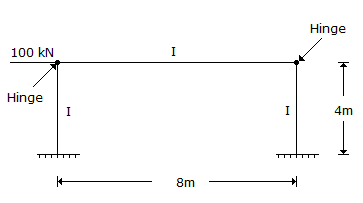Civil Engineering :: GATE Exam Questions
-
In reinforced concrete, pedestal is defined as compression member, whose effective length does not exceed its least dimension by
-
Flexible pavements derive stability primarily from :
-
The permissible bending tensile stress in concrete for the vertical wall of an R.C. water tank made of M 25 concrete is :
-
The cylinder strength of the concrete is less than the cube strength because of
-
A water treatment plant is required to process 28800 m3/d of raw water (density = 1000 kg/m3, kinematic viscosity = 10-6 m2/s). The rapid mixing tank imparts tank a velocity gradient of 900s-1 to blend 35 mg/l of alum with the flow for a detention time of 2 minutes. The power input (W) required for rapid mixing is
-
A single rapid test to determine the pollu-tional status of river water is :
-
Vane tester is normally used for determining in situ shear strength of :
-
For the frame shown in the below figure, the maximum bending moment in the column is,



 Whatsapp
Whatsapp
 Facebook
Facebook









